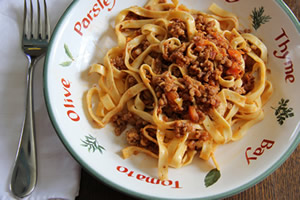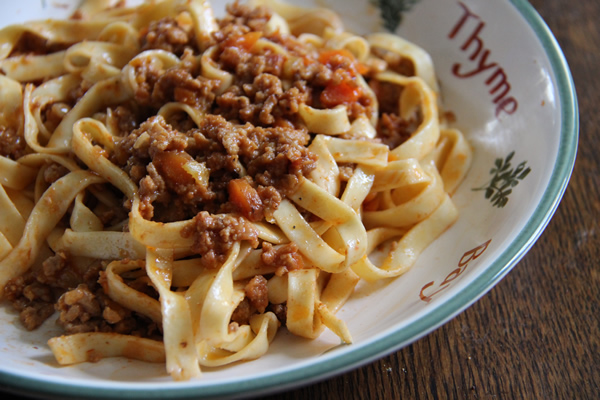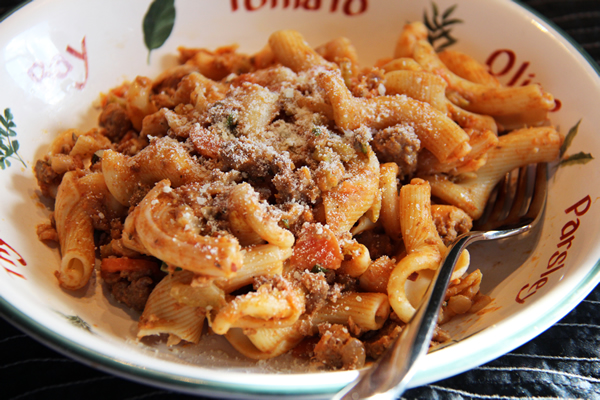A comment from an Italian cooking teacher about our Classic Ragù alla Bolognese from Ada Boni got us thinking about what makes a bolognese a bolognese. In particular, are there chicken livers in its DNA? So we put Recipephany’s Research and Testing Institute to work. Here’s what we learned from our deep dive into the evolution of one of the world’s favorite meat sauces.
A genetic analysis of bolongese ragù’s ancestry brings you immediately to Pellegrino Artusi’s 1891 seminal cookbook, Science in the Kitchen and the Art of Eating Well. The meats Artusi favored for his “Maccheroni Alla Bolognese” (which is curiously tomato-free in a book with many tomato sauces) were simply veal and pancetta. But he also pushed chicken livers. “The sauce can be made even tastier adding small pieces of dried mushroom, a few truffle slices, or a chicken liver cooked with the meat and cut into tiny chunks,” he wrote.
Chicken liver is the Clark Kent of ingredients—adding super depth of flavor and richness to the meat sauce without revealing its true identity.
Artusi’s bolognese influenced our favorite Italian cookbook author, Ada Boni. She’s famous for Il Talismano della Felicità, (Talisman of Happiness, or simply The Talisman) (1928), which was Italy’s standard cookbook for decades.
In The Talisman, Boni built on Artusi’s recipe, adding beef and pork to the veal and pancetta. To crank up the meaty taste, she included not one, but two chicken livers. And there’s tomato paste, for even more umami.
Now here’s where evolution gets interesting.
Boni updated many of her recipes in Italian Regional Cooking (1969), our go-to Italian cooking reference and source of the Classic Ragù alla Bolognese. In this version, she added flavor-boosting sausage to the pancetta, beef and pork, and eliminated veal. Here she included two or three chicken livers to infuse even more of their magic into the ragù.
But she added a qualifier: she marked chicken livers as “optional.” Was this a hint that they were no longer “de rigueur” (or should we say, “de ragù”)?
Chicken livers called into question
Maribel Agullo, who heads the Taste of Italy cooking school in Bologna, contacted Recipephany to say that Italians no longer use chicken livers in their bolognese. She cited the official recipe for Ragù Alla Bolognese (registered with Bologna’s Chamber of Commerce in 1982), which leaves them out.
She explained that chicken livers were popular at a time when no part of the chicken went to waste, particularly around World War II when food was scarce. Livers, giblets and even scraps of intestines went into the meat sauce. Butcher shops prominently displayed them. Her husband’s grandmother, of that generation, added livers to her ragù. The tide shifted well over 20 years ago, she reported, when demand for chicken livers fell off and butcher shops stopped featuring them (although they are still available if you ask). In Bologna, she said, nobody adds chicken livers to their ragù anymore.
The chicken liver work-around
So can we get that signature meaty taste we’ve come to love without chicken livers? Maribel kindly offered a strategy.
“I believe that the use of the livers helps create that depth of flavor when you cook the vegetables first,” she wrote us. “Try cooking the meat first with no condiments—just the meat with some fats (butter, oil) and once you’ve had the Maillard effect then add the veggies, cook them for a bit and proceed with the recipe.”
Two ragùs, head-to-head
Would this do the trick? Recipephany tested two ragùs: Maribel’s work-around without livers, and Ada Boni’s Classic Ragù alla Bolognese.
Maribel’s technique of first browning the meat absolutely intensified the flavor. I was hit by a bold, meaty taste—very aggressive. The fat separated out a bit during the long sautéing, though, and it tended to coat the pasta. The aromatics could have also used a little more time to soften. Yet this was a phenomenal ragù, one I’d be thrilled to get at a restaurant.
But when I tasted Ada Boni’s sauce, the scientific method flew out the window. As I savored her soft, meaty ragù, my bias arrived and pulled up a chair. Like Artusi, I prefer my ragu “even tastier.” If I can find chicken livers to add to the sauce, why should I give them up?
Chicken livers deliver
So now, I must admit to remaining old-school, despite the trend in Italy. And so do others. I recently met a woman at the Italian meats counter in Russo’s Market in Waltham, Massachusetts. She and her Italian husband had lived in Emilia Romagna for over 12 years. When I mentioned bolognese sauce, she had just two words of advice: “Chicken Livers.” She said, “My husband’s family always puts chicken livers into their bolognese. It’s what makes it so meaty tasting.”
The legacy
Pellegrino Artusi’s bolognese can be viewed as both a vestige of its times and an inspiration for future sauces. Like our culture and our genes, bolognese ragù has mutated, and will continue to do so, from area to area, generation to generation.
And as more people stumble upon Artusi’s—and Ada Boni’s—recipes, who knows how many new chefs might add chicken livers to their ragù.
Of course, not everyone embraces the rich, gamey flavor and soft texture of chicken livers. But as meats go, they are good for you—rich in iron, B vitamins, and even eye-healthy vitamin A. You don’t have to invest in a pound of chicken livers to get what you need for the sauce. Every once in a while, save the liver from a whole chicken and freeze it. Even one liver is enough to enrich the sauce.
So click below for that classic recipe from Ada Boni. Add that age-old secret ingredient and see if it takes you back to the origin of this sauce. Find out what helped make Artusi’s sauce all the rage. Maybe you’ll agree with us that it makes your ragù “even tastier.”
Special thanks to Taste of Italy‘s Maribel Agullo, Recipephany’s Special Correspondent in Bologna, for her inspiration, expert advice and contributions to this article. Watch her Taste of Italy YouTube Channel and learn her secrets to authentic Italian cooking and pasta making.









2 Comments
Diane Brody
Dear Leah,
Your comments are the best part of this blog!
Yes, it’s odd we think of tomatoes as central to Italian cooking, but they are from the New World. Pellegrino Artusi’s book does include tomato sauces, and tomato paste is an ingredient in many of his recipes. By not including tomatoes, he may have been preserving the recipe to a very old sauce. When tomato paste appeared later in Ada Boni’s first book, it was just enough to give color and umami, almost like a spice. That’s why Dan calls sauces that are heavy on tomatoes “faux-lognese.”
It’s good to hear chicken livers may be, like anchovies, staging a comeback as a secret ingredient.
I can’t believe I’ve never heard of the Bologna Towers, but now that I’ve Googled them, they are on my must-see list. We passed through Bologna many years ago, only long enough to have some of its legendary food. I’d love go back.
Leah, you make doing Recipephany worthwhile…thank you so much for reading it and following up with such fascinating facts and insights. I love your comments. You add so much to the story!
Thanks again,
Diane
Leah Greenwald
In Italy, Bologna was known for centuries– and may still be– as “Bologna the Fat”, which was a jealous compliment from the other Italian city states. It was agriculturally rich, which also allowed it to be rich in the mercantile sense. Its cuisine is considered one of the top three Italian regional cuisines, which, given the rest of the country, is saying something. The use of pasta predates the advent of tomatoes by at least a few hundred years, since tomatoes originated in the Americas and, even after Europe became aware of them, it was a couple of hundred years before they stopped being eyed with suspicion (they’re from the nightshade family, after all). My guess is that their use became much more widespread after canning was invented in the early 19th century. So it’s unsurprising that tomato paste wasn’t part of the original recipe. I love chicken livers, btw, but I acknowledge they may be an acquired taste. They parallel anchovies, which for the last ten years have been enjoying a culinary comeback as an ingredient which adds flavor but is not readily identifiable when added to sauces etc.
Bologna is very interesting from an architectural viewpoint as well– it’s a great place to visit (if and when we ever travel again). Its original center is largely auto-free, it has wonderful arcaded sidewalks, and it still has many, many buildings with towers; the towers were first built in order to go upstairs and shoot arrows down at one’s enemies. It also has two emblematic towers which are smaller than, but also lean over more, than the one in Pisa. Between it and Ravenna, which is about an hour away, you can see many buildings from about 300 A.D. on.